The City Naturalist
Canada Goose
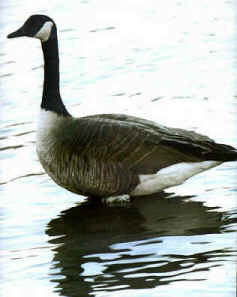 Article
and Photos by Leslie Day
Article
and Photos by Leslie Day
CANADA GOOSE, (Branta canadensis: genus name Brant from Anglo-Saxon bernan to burn, named because of charred, dark, overall color; species name: canadensis, Latin "of Canada"). Other names: Bay goose, big gray goose, black-headed goose, calling goose, Canada brant, common wild goose, honker, wild goose.
LOCALLY: The Canada Geese have been wintering and summering at the Boat Basin since 1983. We have seen at least one pair build their nest on the clusters of pilings (called "dolphins") south of the marina each spring, opposite the running track at 72nd street by the Hudson in Riverside Park.. In the past, they have successfully raised two to four goslings (baby geese). However in the summer of 1993 one pair raised six goslings.
Because the Swans that have been wintering at the marina since 1992 usually do not tolerate the presence of geese, the Canada Geese do not return to the Boat Basin until the swans leave for their breeding grounds. In the winter of 1997 the swans left in mid February, a month earlier than usual, perhaps due to the unusually warm winter. The next day the Canada Geese arrived: one large group of 12, one family with two yearlings (goslings almost one year old) and one mated pair with no goslings.
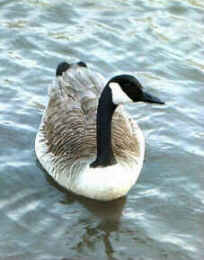 DESCRIPTION:
The Canada Goose is the most widely distributed and
possibly best known of all North American waterfowl. This goose
is the common wild goose of the North American continent. They
live from the Atlantic to Pacific coast and from Mexico north to
the Arctic Coast of Canada. This goose has at least 10 races or
subspecies all similar in color pattern, with long black necks
and black heads with large white cheek patches which meet under
the throat; brown-gray body with pale to dark breast and
underparts, black tail with 16-20 tail feathers and white upper
and undertail coverts which are the small feathers on top of
wings and over and under tail feathers. A diagnostic marking, the
crescent of white feathers just above tail is apparent during
flight. The bill and feet are black. The giant Canada Goose,
which can be seen here at the 79th Street Marina, can be up to 48
inches long with a wingspan of 75 inches and weighing up to 24
pounds.
DESCRIPTION:
The Canada Goose is the most widely distributed and
possibly best known of all North American waterfowl. This goose
is the common wild goose of the North American continent. They
live from the Atlantic to Pacific coast and from Mexico north to
the Arctic Coast of Canada. This goose has at least 10 races or
subspecies all similar in color pattern, with long black necks
and black heads with large white cheek patches which meet under
the throat; brown-gray body with pale to dark breast and
underparts, black tail with 16-20 tail feathers and white upper
and undertail coverts which are the small feathers on top of
wings and over and under tail feathers. A diagnostic marking, the
crescent of white feathers just above tail is apparent during
flight. The bill and feet are black. The giant Canada Goose,
which can be seen here at the 79th Street Marina, can be up to 48
inches long with a wingspan of 75 inches and weighing up to 24
pounds.
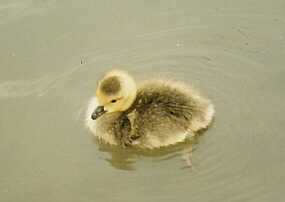 BREEDING:
Canada Geese mate for life and are deeply devoted to one another.
"Sagacity, wariness, strength and fidelity are
characteristics of the Canada goose which, collectively, are
possessed in the same degree by no other bird," wrote a
naturalist many years ago. Geese are among the very few birds in
which the family does not break up at the end of the breeding
season; parents and their young raised during the summer have
established strong family bonds and stay together almost a year.
They migrate together in the fall in flocks containing many other
family units. Each family stays together on the wintering
grounds. The family migrates northward together in spring, with
adult pairs usually returning to the nest territory that each
pair established in the previous years. Once back to their
breeding ground, the young of the previous nesting season, now
called "yearlings," separate from their parents and
form flocks with other yearlings. Yearlings most often move
considerable distances (up to several hundred miles) from their
parents.
BREEDING:
Canada Geese mate for life and are deeply devoted to one another.
"Sagacity, wariness, strength and fidelity are
characteristics of the Canada goose which, collectively, are
possessed in the same degree by no other bird," wrote a
naturalist many years ago. Geese are among the very few birds in
which the family does not break up at the end of the breeding
season; parents and their young raised during the summer have
established strong family bonds and stay together almost a year.
They migrate together in the fall in flocks containing many other
family units. Each family stays together on the wintering
grounds. The family migrates northward together in spring, with
adult pairs usually returning to the nest territory that each
pair established in the previous years. Once back to their
breeding ground, the young of the previous nesting season, now
called "yearlings," separate from their parents and
form flocks with other yearlings. Yearlings most often move
considerable distances (up to several hundred miles) from their
parents.
 MOLTING:
After the breeding season, when the young are half grown, the
adults loose their flight and tail feathers in molt; they are
flightless for about a month until their new feathers have grown
and they are flying again at about the time the young start their
first flights.
MOLTING:
After the breeding season, when the young are half grown, the
adults loose their flight and tail feathers in molt; they are
flightless for about a month until their new feathers have grown
and they are flying again at about the time the young start their
first flights.
 NESTING:
The goose incubates five or six creamy eggs for 28 to 30 days.
The gander (male) constantly guards her, and never is his
strength and fidelity more in evidence. We have seen one gander
fiercely chase other geese away from the nest. Within 24 hours of
hatching, the parents lead their goslings from the nest to open
water, or if in a tree (or piling) nest, coax them to leap to the
ground or water. In May 1995 we saw a tiny newly hatched gosling
jump from the top of a piling into the river, a distance of 20
feet or more. The goslings can dive, swim and feed themselves
while guarded by adults. Goslings can dive and swim for 30-40
feet underwater and they eat almost continuously to attain growth
for the first southward migration. On the water, the gander
usually leads, the goslings string out in single file with the
female bringing up the rear. The newly hatched goslings are
small, very round, fuzzy, and greenish yellow in color.
NESTING:
The goose incubates five or six creamy eggs for 28 to 30 days.
The gander (male) constantly guards her, and never is his
strength and fidelity more in evidence. We have seen one gander
fiercely chase other geese away from the nest. Within 24 hours of
hatching, the parents lead their goslings from the nest to open
water, or if in a tree (or piling) nest, coax them to leap to the
ground or water. In May 1995 we saw a tiny newly hatched gosling
jump from the top of a piling into the river, a distance of 20
feet or more. The goslings can dive, swim and feed themselves
while guarded by adults. Goslings can dive and swim for 30-40
feet underwater and they eat almost continuously to attain growth
for the first southward migration. On the water, the gander
usually leads, the goslings string out in single file with the
female bringing up the rear. The newly hatched goslings are
small, very round, fuzzy, and greenish yellow in color.
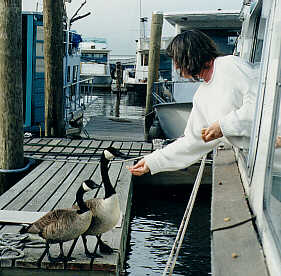
 FEEDING:
Here at the 79th Street Boat Basin, the geese dabble and feed on
the tidal flats, eating mollusks and small crustaceans. In
fields, they are essentially grazers and with their bill they
will crop marsh grasses, or fresh blades of sprouting winter
wheat. In ponds and lakes, they eat bulrushes, salt and brome
grass, clovers, cattails and other plants. They plunge their head
and neck below the surface with tail tipped up to feed on roots,
tubers, leaves and seeds of algae and pondweeds.
FEEDING:
Here at the 79th Street Boat Basin, the geese dabble and feed on
the tidal flats, eating mollusks and small crustaceans. In
fields, they are essentially grazers and with their bill they
will crop marsh grasses, or fresh blades of sprouting winter
wheat. In ponds and lakes, they eat bulrushes, salt and brome
grass, clovers, cattails and other plants. They plunge their head
and neck below the surface with tail tipped up to feed on roots,
tubers, leaves and seeds of algae and pondweeds.
PECKING ORDER: In the social hierarchy of geese, families dominate mated pairs without families, not tolerating them within the limits of the family flock territory; mated pairs dominate over single adults and yearlings; yearlings over immatures. While watching the geese here at the Boat Basin you will have the opportunity to see this pecking order in action. While we are feeding the families, they will chase away mated pairs, single adults and yearlings with their loud honking voices.
VOICE: a deep musical honking - ah-honk, or ka-ronk, ka-lunk - with a break in middle of the two syllables, the second drawn out and highest in pitch. A flock flying in their typical V formation and calling from a distance sounds like a pack of baying hounds.
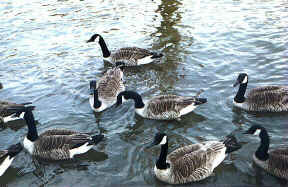 MIGRATION:
The Canada Goose is one of earliest migrants in spring, flying by
night or day. Those that have wintered farthest south may start
to migrate a month earlier than those that have wintered farther
north at or above the frost line. They move northward slowly,
their advance corresponding closely with the advance of spring,
and arrive at their northern nesting grounds by late March. An
adult male of the family flock starts local flights by vigorously
tossing his head and voicing a low guttural "talking".
At such times it is usually the females that leads the flight,
with the male (easily identified by his larger size) guarding the
rear. In spring migration, the females of the already mated pairs
lead the male partner in flight, but the leadership at the head
of the flock changes from time to time.
MIGRATION:
The Canada Goose is one of earliest migrants in spring, flying by
night or day. Those that have wintered farthest south may start
to migrate a month earlier than those that have wintered farther
north at or above the frost line. They move northward slowly,
their advance corresponding closely with the advance of spring,
and arrive at their northern nesting grounds by late March. An
adult male of the family flock starts local flights by vigorously
tossing his head and voicing a low guttural "talking".
At such times it is usually the females that leads the flight,
with the male (easily identified by his larger size) guarding the
rear. In spring migration, the females of the already mated pairs
lead the male partner in flight, but the leadership at the head
of the flock changes from time to time.
About Leslie Day | For Further Information
Copyright © 1996-2012 The 79th Street Boat Basin Flora and Fauna Society.
